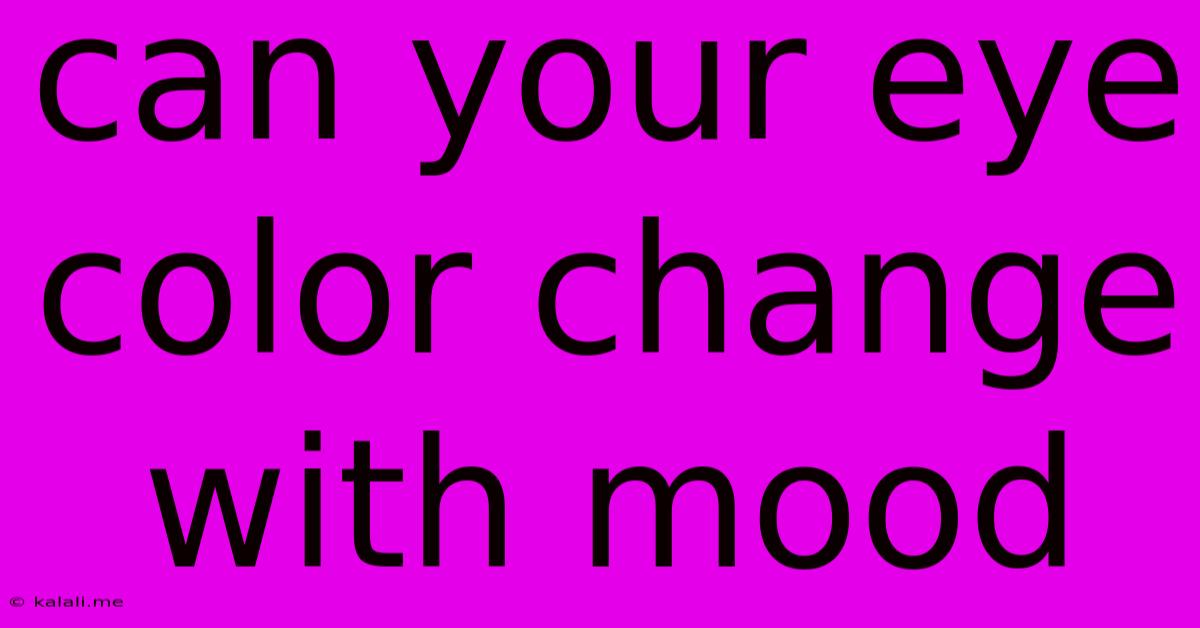Can Your Eye Color Change With Mood
Kalali
Jun 03, 2025 · 3 min read

Table of Contents
Can Your Eye Color Change With Your Mood? Exploring the Science Behind Shifting Shades
Meta Description: Discover the truth behind the fascinating question: Can your eye color actually change with your mood? We delve into the science, exploring the possibilities and limitations of mood-related eye color shifts.
Have you ever wondered if your eye color could subtly shift depending on your emotions? The idea of eyes mirroring internal states, changing from a calm blue to a stormy grey with anger, is captivating. While dramatic, instantaneous shifts in eye color with mood are largely a myth, there are some nuanced factors that can lead to perceived changes, and some rare conditions that cause actual, albeit subtle, variations. Let's explore the science behind this intriguing phenomenon.
The Biology of Eye Color: A Foundation for Understanding
Eye color is primarily determined by the amount and distribution of melanin, a pigment, in the iris. Genetic inheritance plays the most significant role, defining the base color – brown, blue, green, hazel, and variations thereof. The intricate interplay of melanin and light scattering within the iris creates the spectrum of eye colors we see.
Factors That Can Influence Apparent Eye Color Changes
While your fundamental eye color remains relatively consistent, several factors can create the illusion of a shift:
-
Lighting Conditions: This is perhaps the most significant factor. Different light sources – sunlight, incandescent bulbs, fluorescent lights – can dramatically alter how your eye color appears. A warm, yellowish light might make brown eyes appear darker, while cool blue light could enhance the blue tones in your eyes.
-
Pupil Dilation: Your pupils constrict and dilate in response to light levels and emotional states. A dilated pupil (larger) can sometimes make the iris appear slightly different in shade, especially in individuals with lighter eye colors. This is more a change in the apparent size and contrast of the iris rather than a true color change.
-
Blood Vessel Changes: Emotional states, especially stress and excitement, can influence blood flow around the eye. This can subtly alter the appearance of the iris, potentially leading to a slight perceived shift in color. This effect is usually minimal and temporary.
-
Eye Health and Medication: Certain eye conditions or medications can temporarily affect the appearance of the eye color. These changes, however, are not directly related to mood but rather to physiological alterations.
Rare Medical Conditions with Eye Color Changes
There are extremely rare medical conditions that can cause true, albeit often subtle, changes in eye color. These are usually associated with underlying health issues and not directly linked to emotional states:
-
Pigmentary disorders: Certain conditions can affect melanin production in the iris, leading to changes in eye color over time. These changes are gradual and not linked to immediate emotional responses.
-
Trauma: In rare cases, severe trauma to the eye can affect melanin production and cause a change in eye color. This is a significant medical event, not a simple mood-related alteration.
Debunking the Myth: No Instantaneous Mood-Based Color Shifts
It's crucial to dispel the myth of dramatic, instantaneous eye color shifts based on mood. While lighting, pupil dilation, and blood vessel changes can create subtle variations in appearance, they don't fundamentally alter the underlying melanin distribution in the iris. True changes in eye color are usually due to medical conditions or gradual changes over a long period, and are not instantaneous responses to emotional stimuli.
Conclusion: The Allure of Shifting Shades
The idea of our eyes reflecting our inner emotional landscape is undeniably captivating. While instantaneous mood-driven eye color changes are largely a misconception, the subtle ways lighting and physiology can influence our eye's appearance remain fascinating. Understanding the biological realities helps us appreciate the complexities of this captivating feature and its potential for seemingly magical shifts in perception.
Latest Posts
Latest Posts
-
Why Has Dog Not Teleported After Swimming
Jun 04, 2025
-
How To Write Actions Between Dialogue
Jun 04, 2025
-
Super Mario Brothers Wii Mushroom House Cheats
Jun 04, 2025
-
Power Series Representation Of Ln 1 X
Jun 04, 2025
-
Can You Replace Just One Rim On A Car
Jun 04, 2025
Related Post
Thank you for visiting our website which covers about Can Your Eye Color Change With Mood . We hope the information provided has been useful to you. Feel free to contact us if you have any questions or need further assistance. See you next time and don't miss to bookmark.